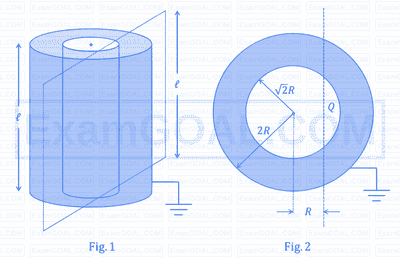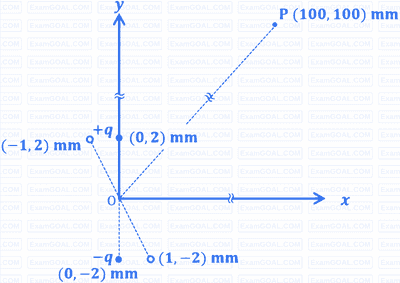
Two co-axial conducting cylinders of same length $\ell$ with radii $\sqrt{2}R$ and $2R$ are kept, as shown in Fig. 1. The charge on the inner cylinder is $Q$ and the outer cylinder is grounded. The annular region between the cylinders is filled with a material of dielectric constant $\kappa=5$. Consider an imaginary plane of the same length $\ell$ at a distance $R$ from the common axis of the cylinders. This plane is parallel to the axis of the cylinders. The cross-sectional view of this arrangement is shown in Fig. 2. Ignoring edge effects, the flux of the electric field through the plane is ($\epsilon_0$ is the permittivity of free space):


List-I shows four configurations, each consisting of a pair of ideal electric dipoles. Each dipole has a dipole moment of magnitude $p$, oriented as marked by arrows in the figures. In all the configurations the dipoles are fixed such that they are at a distance $2 r$ apart along the $x$ direction. The midpoint of the line joining the two dipoles is $X$. The possible resultant electric fields $\vec{E}$ at $X$ are given in List-II.
Choose the option that describes the correct match between the entries in List-I to those in List-II.
| List–I | List–II |
|---|---|
(P)  |
(1) $$ \vec{E}=0 $$ |
(Q)  |
(2) $\displaystyle \vec{E} = -\,\frac{p}{2\pi\epsilon_0\,r^3}\,\hat{\jmath}$ |
(R)  |
(3) $\displaystyle \vec{E} = -\,\frac{p}{4\pi\epsilon_0\,r^3}\,(\hat{\imath} - \hat{\jmath})$ |
(S)  |
(4) $\displaystyle \vec{E} = \frac{p}{4\pi\epsilon_0\,r^3}\,(2\hat{\imath} - \hat{\jmath})$ |
| (5) $\displaystyle \vec{E} = \frac{p}{\pi\epsilon_0\,r^3}\,\hat{\imath}$ |

Two beads, each with charge $q$ and mass $m$, are on a horizontal, frictionless, non-conducting, circular hoop of radius $a$. One of the beads is glued to the hoop at some point, while the other one performs small oscillations about its equilibrium position along the hoop. The square of the angular frequency of the small oscillations is given by
[ $\varepsilon_0$ is the permittivity of free space.]

